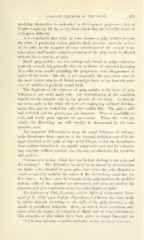Page 421 - My FlipBook
P. 421
CALCIFIC CHANGES IN THE PULP. 419
modating themselves to each otlier as development progresses, they at
length completely fill the cavity, from Avhich tliey are severally removed
with great difficulty.
It is remarkable that while in some instances pul]) nodules become
the cause of producing violent pain by their pressure upon the nerves
of the pulp, in the majority of cases substitution of the normal tissue
takes place until nearly complete occlusion of the pulp cavity is affected
without the occurrence of pain.
Small pulp nodules are not infrequently found in pulps otherwise
perfectly normal, but generally they are evidence of continued irritation
of a mild form usually attending the progressive slow advancement of
caries of the tooth. But this is not necessarily the case, since some of
the most violent attacks of dental neuralgia have arisen from the pres-
ence of nodules in perfectly sound teeth.
The diagnosis of the existence of pulp nodules as the cause of pulp
irritation is not easily made out. The determination of the condition
usually can be reached only by the process of exclusion. As they do
not occur early in life while the teeth are undergoing ordinary develop-
ment, they may be looked for only after middle life. The pain is dull
and reflected, and the paroxysms are frequent. There is sensibilitv to
cold, and rarely pain appears on percussion. AVhen the teeth are
sound, the disturbing one will usually be determined by the tem-
perature tests.
An important differentiation from the usual irritation of ordinary
pulp disturbance from exposure or the thermal irritation caused by the
approximation to the pulp of large metal fillings, is that the disturbance
from nodular irritation is not rapidly progressive and that the irritation
may continue without marked exacerbations or subsidence for consider-
able periods.
Treatment is useless which does not include drilling to the pulji and
devitalizing it. The difficulties involved in treatment by devitalization
are liable to be attended by great pain, since when the pulp chamber is
much occupied by nodules the action of the devitalizing agent has not
free course. In these cases tlie remains of the pulp between the nodules
and the walls of the chamber are attenuated, and wlien irritated by the
arsenous acid give expression to an excessive degree of pain.'
The Influence of Pulp Exposure, and the Effect of Conservative Treat-
ment of the Pulp upon Calcific Pepof^itions.—Allusion has been made
to calcific deposits occurring on the walls of the pulp chamber as the
result of peripheral irritation. Here, as stated, these accretions only
occur when the degree of irritation is slight and of long continuance.
The examples of this which have been given in dental literature are
^ For the form and extent of nodular calcification see American System of iJentisiry.


